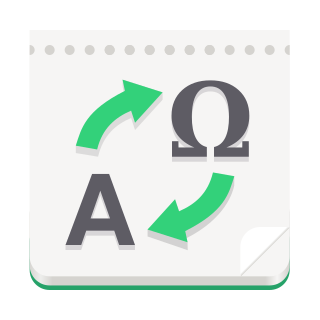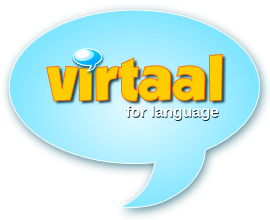A translation memory (TM) is a database that stores "segments", which can be sentences, paragraphs or sentence-like units that have previously been translated, in order to aid human translators. The translation memory stores the source text and its corresponding translation in language pairs called “translation units”. Individual words are handled by terminology bases and are not within the domain of TM.

A parallel text is a text placed alongside its translation or translations. Parallel text alignment is the identification of the corresponding sentences in both halves of the parallel text. The Loeb Classical Library and the Clay Sanskrit Library are two examples of dual-language series of texts. Reference Bibles may contain the original languages and a translation, or several translations by themselves, for ease of comparison and study; Origen's Hexapla placed six versions of the Old Testament side by side. A famous example is the Rosetta Stone, whose discovery allowed the Ancient Egyptian language to begin being deciphered.
A programming tool or software development tool is a computer program that software developers use to create, debug, maintain, or otherwise support other programs and applications. The term usually refers to relatively simple programs, that can be combined to accomplish a task, much as one might use multiple hands to fix a physical object. The most basic tools are a source code editor and a compiler or interpreter, which are used ubiquitously and continuously. Other tools are used more or less depending on the language, development methodology, and individual engineer, often used for a discrete task, like a debugger or profiler. Tools may be discrete programs, executed separately – often from the command line – or may be parts of a single large program, called an integrated development environment (IDE). In many cases, particularly for simpler use, simple ad hoc techniques are used instead of a tool, such as print debugging instead of using a debugger, manual timing instead of a profiler, or tracking bugs in a text file or spreadsheet instead of a bug tracking system.
A translation management system (TMS), formerly globalization management system (GMS), is a type of software for automating many parts of the human language translation process and maximizing translator efficiency. The idea of a translation management system is to automate all repeatable and non-essential work that can be done by software/systems and leaving only the creative work of translation and review to be done by human beings. A translation management system generally includes at least two types of technology: process management technology to automate the flow of work, and linguistic technology to aid the translator.

OmegaT is a computer-assisted translation tool written in the Java programming language. It is free software originally developed by Keith Godfrey in 2000, and is currently developed by a team led by Aaron Madlon-Kay.

The name Wordfast is used for any number of translation memory products developed by Wordfast LLC. The original Wordfast product, now called Wordfast Classic, was developed by Yves Champollion in 1999 as a cheaper alternative to Trados, a translation memory program. The current Wordfast products run on a variety of platforms but use largely compatible translation memory formats, and often also have similar workflows. The software is most popular with freelance translators, although some of the products are also suited for corporate environments.

Gtranslator is a specialized computer-assisted translation software and po file editor for the internationalization and localization (i18n) of software that uses the gettext system. It handles all forms of gettext po files and includes features such as Find/Replace, Translation Memory, different Translator Profiles, Messages Table, Easy Navigation and Editing of translation messages and comments of the translation where accurate. Gtranslator includes also a plugin system with plugins such as Alternate Language, Insert Tags, Open Tran, Integration with Subversion, and Source Code Viewer. Gtranslator is written in the programming language C for the GNOME desktop environment. It is available as free software under the terms of the GNU General Public License (GPL).

Virtaal is a computer-assisted translation tool written in the Python programming language. It is free software developed and maintained by Translate.org.za.
Trados Studio is a computer-assisted translation software tool which provides a comprehensive platform for translation tasks, including editing, reviewing, and project management. It is available both as a local desktop tool or online. Trados, owned by RWS, also provides a suite of intelligent machine translation products.
GlobalSight is a free and open source translation management system (TMS) released under the Apache License 2.0. As of version 7.1 it supports the TMX and SRX 2.0 Localization Industry Standards Association standards. It was developed in the Java programming language and uses a MySQL database. GlobalSight also supports computer-assisted translation and machine translation.
Fuzzy matching is a technique used in computer-assisted translation as a special case of record linkage. It works with matches that may be less than 100% perfect when finding correspondences between segments of a text and entries in a database of previous translations. It usually operates at sentence-level segments, but some translation technology allows matching at a phrasal level. It is used when the translator is working with translation memory (TM). It uses approximate string matching.
Open Language Tools is a Java project released by Sun Microsystems under the terms of Sun's CDDL.
openTMS is an acronym for Open Source Translation Management System.
Google Translator Toolkit was an online computer-assisted translation tool (CAT)—a web application designed to permit translators to edit the translations that Google Translate automatically generated using its own and/or user-uploaded files of appropriate glossaries and translation memory. The toolkit was designed to let translators organize their work and use shared translations, glossaries and translation memories, and was compatible with Microsoft Word, HTML, and other formats.
Caitra is a translation Computer Assisted Tool, or CAT, developed by the University of Edinburgh. Provided from an online platform, Caitra is based on AJAX Web.2 technologies and the Moses decoder. The web page of the tool is implemented with Ruby on Rails, an open source web framework, and C++.
The name MetaTexis is used for several software products developed by MetaTexis Software and Services. The main software products are MetaTexis for Word and the MetaTexis Server. MetaTexis for Word is a translation memory software, also called a Computer-assisted translation tool, that runs inside Microsoft Word. The MetaTexis Server is a server software for translation memories (TMs) and terminology databases (TDBs) that allows numerous translators to work with the same TMs and TDBs via LAN or Internet.
MultiTerm is a terminology management tool providing one solution to store and manage multilingual terminology.
The following outline is provided as an overview of and topical guide to natural-language processing:
memoQ is a proprietary computer-assisted translation software suite which runs on Microsoft Windows operating systems. It is developed by the Hungarian software company memoQ Fordítástechnológiai Zrt., formerly Kilgray, a provider of translation management software established in 2004 and cited as one of the fastest-growing companies in the translation technology sector in 2012, and 2013. memoQ provides translation memory, terminology, machine translation integration and reference information management in desktop, client/server and web application environments.
MateCat is a web-based computer-assisted translation (CAT) tool, released as open-source software under the Lesser General Public License (LGPL).




